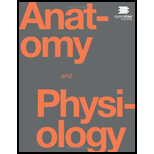
Concept explainers
Go to this website (http://openstaxcollege.org/l/childhand) to view a radiograph (X-ray image) of a child’s hand and wrist. The growing bones of child have an epiphyseal plate that forms a synchondrosis between the shaft and end of a long bone. Being less dense than bone, the area of epiphyseal cartilage is seen on this radiograph as the dark epiphyseal gaps located near the ends of the long bones, including the radius, ulna, metacarpal, and phalanx bones. Which of the bones in this image do not show an epiphyseal plate (epiphyseal gap)?
To write:
To determine the bones in the radiograph of a growing child's wrist and hand which does not have an epiphyseal plate.
Introduction:
Epiphyseal plate is a plate of hyaline cartilage which is present at the end of long bones. It determines the extent of growth of the bone. So, it is present at the ends of growing bones.
Explanation of Solution
In the radiograph of hand and wrist of a child, epiphyseal plate is present at the end of all the bones except the carpals. Carpal bone is small bones in the area of the wrist which grow in diameter. They do not grow in length so they do not have an epiphyseal plate.
Epiphyseal plate is not present in the carpal bones of the hand.
Want to see more full solutions like this?
Chapter 9 Solutions
Anatomy & Physiology
Additional Science Textbook Solutions
College Physics
Campbell Biology (11th Edition)
Campbell Essential Biology (6th Edition) - standalone book
Human Anatomy & Physiology (2nd Edition)
Campbell Essential Biology (7th Edition)
Microbiology: An Introduction
- Among other bones, the axial skeleton includes the_____. a. thoracic cage and vertebral column b. thoracic cage and pectoral girdle c. skull and pelvic girdle d. pectoral and pelvic girdlesarrow_forwardOsteomalacia, also known as adult rickets, is abnormal softening of bones in adults. ______ _______ _______ _______arrow_forward______are shock pads and flex points. a. Vertebrae b. Cervical bones c. Lumbar bones d. Intervertebral disksarrow_forward
- Figure 38.19 Which of the following statements about bone tissue is false? Compact bone tissue is made of cylindrical osteons that are aligned such that they travel the length of the bone. Haversian canals contain blood vessels only. Haversian canals contain blood vessels and nerve fibers. Spongy tissue is found on the inferior of the bone, and compact bone tissue is found on the exterior.arrow_forwardThe opening in a bone through which blood vessels, nerves, and ligaments pass is a ____________. foramen foramina process symphysisarrow_forwardA normal projection on the surface of a bone that serves as an attachment for muscles and tendons is known as a/an___________ cruciate exostosis popliteal processarrow_forward
- When Bobby Kuhn fell out of a tree, the bone in his arm was bent and partially broken. Dr. Grafton described this as a/an _____________________ fracture and told the family that this type of fracture occurs primarily in children.arrow_forwardBones grow in length due to activity in the ________. epiphyseal plate perichondrium periosteum medullary cavityarrow_forwardOsteoporosis is a common age-related bone disease in which bone density and strength is decreased. Watch this video (http://openstaxcollege.org/l/osteoporosis) to get a better understanding of how thoracic vertebrae may become weakened and may fractured due to this disease. How may vertebral osteoporosis contribute to kyphosis?arrow_forward
 Anatomy & PhysiologyBiologyISBN:9781938168130Author:Kelly A. Young, James A. Wise, Peter DeSaix, Dean H. Kruse, Brandon Poe, Eddie Johnson, Jody E. Johnson, Oksana Korol, J. Gordon Betts, Mark WomblePublisher:OpenStax College
Anatomy & PhysiologyBiologyISBN:9781938168130Author:Kelly A. Young, James A. Wise, Peter DeSaix, Dean H. Kruse, Brandon Poe, Eddie Johnson, Jody E. Johnson, Oksana Korol, J. Gordon Betts, Mark WomblePublisher:OpenStax College Biology 2eBiologyISBN:9781947172517Author:Matthew Douglas, Jung Choi, Mary Ann ClarkPublisher:OpenStax
Biology 2eBiologyISBN:9781947172517Author:Matthew Douglas, Jung Choi, Mary Ann ClarkPublisher:OpenStax Concepts of BiologyBiologyISBN:9781938168116Author:Samantha Fowler, Rebecca Roush, James WisePublisher:OpenStax College
Concepts of BiologyBiologyISBN:9781938168116Author:Samantha Fowler, Rebecca Roush, James WisePublisher:OpenStax College Human Biology (MindTap Course List)BiologyISBN:9781305112100Author:Cecie Starr, Beverly McMillanPublisher:Cengage Learning
Human Biology (MindTap Course List)BiologyISBN:9781305112100Author:Cecie Starr, Beverly McMillanPublisher:Cengage Learning Medical Terminology for Health Professions, Spira...Health & NutritionISBN:9781305634350Author:Ann Ehrlich, Carol L. Schroeder, Laura Ehrlich, Katrina A. SchroederPublisher:Cengage Learning
Medical Terminology for Health Professions, Spira...Health & NutritionISBN:9781305634350Author:Ann Ehrlich, Carol L. Schroeder, Laura Ehrlich, Katrina A. SchroederPublisher:Cengage Learning





